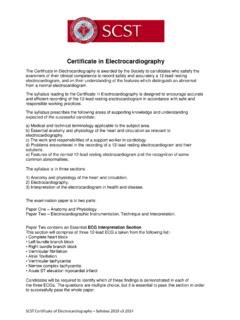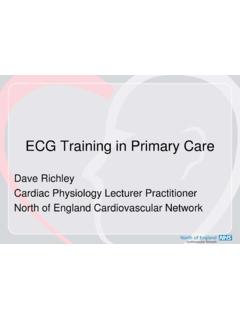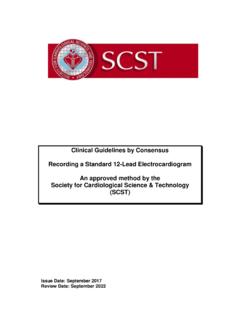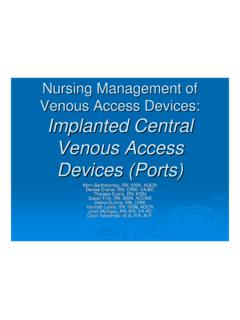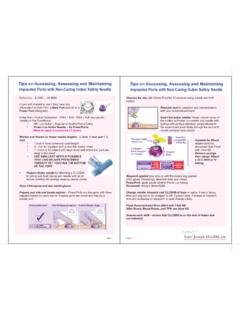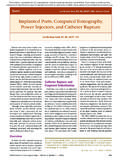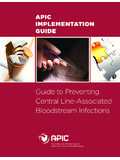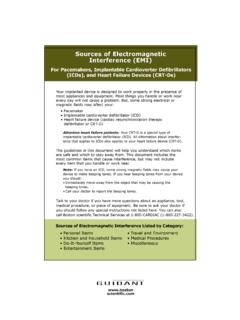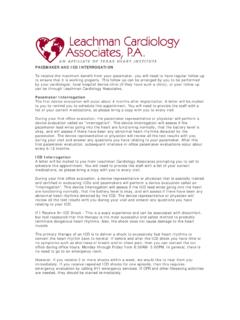Transcription of CARDIAC IMPLANTABLE DEVICE FOLLOW UP …
1 GUIDELINES FOR FOLLOW UP OF IMPLANTABLE . CARDIAC devices FOR CARDIAC RHYTHM. MANAGEMENT. October 2008. Sue Jones, Michael Gammage and Nick Linker for HRUK; Brian Campbell and Wilson McNair for SCST. INTRODUCTION. Guidelines for pacemaker FOLLOW up were first published in Heart in November 19961 as the result of a British Pacing and Electrophysiology Group (BPEG). policy conference. These were agreed by consensus and have been the primary source of guidance for the management of implanted devices within the UK to date. The continuing evolution of DEVICE technology has resulted in the production of a range of devices capable of treating bradycardias, complex CARDIAC tachyarrhythmias, and heart failure management. These devices have multiple modalities and programmable features. The challenge of these treatments lies not only in the implantation of the devices but also in comprehensive FOLLOW -up of the implanted devices as part of the lifelong management of the patient.
2 As the number and variety of implanted devices increase so does the burden of FOLLOW -up and the knowledge required to optimise and troubleshoot their use. This is compounded by the increasing volume of data provided by devices , and the increasing sophistication of programming therapy and detection algorithms2. As a result of this increasing complexity, inappropriate or incorrect use of these algorithms or other errors with aspects of DEVICE programming may result in serious harm to the patient. DEVICE FOLLOW -up clinics now encompass various types of devices ranging from single/dual chamber bradycardia devices , atrial tachycardia devices and IMPLANTABLE cardioverter defibrillators, to multi-chamber CARDIAC resynchronisation devices incorporating new modalities such as impedance monitors for assessing heart failure. Although the original guidelines stated that pacemaker clinics should be the responsibility of a lead physician, the practice of DEVICE management FOLLOW -up in the UK is now almost solely led and practiced by CARDIAC Physiologists (CPs), and in some cases by specialist nurses.
3 It is vital therefore that clinical governance mechanisms and lines of clinical responsibility are clearly established for all FOLLOW -up clinics. 1. DEVICE FOLLOW -up remains the clinical responsibility of the Consultant Cardiologist (consultant physician with specialist interest) in charge of the DEVICE FOLLOW -up service although it is a CARDIAC Physiologist run service. Physicians providing such a service should have the required knowledge to do so. Ideally, such physicians would be current holders of (or working towards) a recognised pacing qualification such as certificate of accreditation with Heart Rhythm UK (HRUK, previously BPEG exam), European Heart Rhythm Association (EHRA) or International Boards of Heart Rhythm Examiners (IBHRE, formerly North American Society of Pacing and Electrophysiology (NASPE)). The following guidelines for CARDIAC Physiologist led clinics have been drawn up by HRUK and the Society for Cardiological Science and Technology (SCST), both of which are affiliated groups of the British Cardiovascular Society.
4 These groups have been instrumental in guiding DEVICE FOLLOW up training since the previous policy conference conducted by the British Pacing and Electrophysiology Group (now HRUK). Section A Bradycardia Pacemaker FOLLOW up Clinics There should be a clearly defined protocol documenting the lines of communication and support between the lead CARDIAC Physiologist for the bradycardia pacemaker FOLLOW -up service and the Consultant Cardiologist (consultant physician with specialist interest) responsible for the onsite service to ensure that clinical governance requirements are met. The lead CARDIAC Physiologist for bradycardia pacemaker FOLLOW -up services at non-implanting hospitals must also have strong links with the lead CARDIAC Physiologist and Consultant Cardiologist at the implant centre. The lines of clinical responsibility must be clearly defined in the local trust policy. Trusts delivering bradycardia pacemaker FOLLOW -up services have a responsibility to ensure appropriate arrangements are in place to cover clinic activity (elective or urgent).
5 Bradycardia Pacemaker FOLLOW -up Clinic Objectives: 1. To optimise the pacing system to the individual patient needs whilst maximising generator life. Safety must be paramount whilst manufacturer guidance and HRUK recommendations should also be taken into account. 2. To identify any abnormalities in the pacemaker system and complications of the therapy in order to ensure prompt treatment. 3. To assess battery status to predict end-of-life (EOL) of the pulse generator in order to permit timely elective generator replacement. 4. To provide patient and family support and education. 5. To ensure that the patient's experience is as safe, comfortable and reassuring as possible. 6. To ensure that safe and accurate measurements are made of DEVICE and lead function and that accurate records of each visit are kept. Staff leading the clinic must be able to recognise problems and complications and make the appropriate changes or recommendations. 7. To monitor the DEVICE implant site and manage any risk of infection.
6 2. 8. To maximise clinical safety and efficiency in line with clinical governance requirements. 9. To regularly review patients in line with local, manufacturer and National guidelines. 10. To implement relevant advisories from DEVICE manufacturers and the Medicines and Healthcare products Regulatory Agency (MHRA) guidelines and advice. 11. To notify the MHRA and manufacturer of any problems arising with devices or leads. 12. To be aware of the need to identify clinical problems and refer patients for immediate or deferred medical care appropriately in line with local policy. 13. To provide accurate and complete communication about patient- DEVICE interaction and appropriate functionality to GPs and other relevant health professionals. Suggested Procedure for Referrals to a Bradycardia Pacemaker Service FOLLOW -Up Clinic at non-implant centres On receipt of referral from implant physician/centre the patient is registered and scheduled for review. The referral information must include: Patient name and address and telephone number Patient GP details Hospital / H&C number Date of birth Referring consultant Pacemaker type and parameters Pacemaker lead models and serial numbers Most recent threshold, battery voltage and lead impedance evaluation results Patient mobility Cross infection issues Indications for implant Medication details.
7 Suggested appointments schedule Yearly for pacemakers implanted for less than 7-10 years depending on the manufacturers recommendation and expected battery longevity. 6 monthly for implants exceeding 7-10 years until ERI is reached. 3-6 monthly for devices that exceed the manufacturers suggested longevity or show decline in battery life. At CARDIAC Physiologists discretion for devices that require closer monitoring programming/lead issues. Reports A report is generated by CARDIAC Physiologists in charge of the FOLLOW -up clinic and all parameters and clinical details are documented in department's database and/or the patient's pacemaker notes. A copy of the report or a letter is sent to the patient's general practitioner and the referring hospital where appropriate. 3. The implant centre need only be contacted when seeking additional advice or when making a referral to the implanting physician. Staffing: Qualifications and Training Ideally the clinic should be manned with two staff, one of who meets the lead role competencies.
8 The Second staff member can be undergoing training. Lead CARDIAC Physiologist A qualified CARDIAC Physiologist (BSc Clinical Physiology or equivalent). Evidence of post-graduate training in CARDIAC rhythm management techniques, holds appropriate Certification of Accreditation HRUK or IBHRE. Hold current ILS or ALS accreditation Evidence of Continual Professional Development (CPD) in CARDIAC rhythm management Perform minimum of 100 bradycardia pacemaker system FOLLOW -up review procedures per year Attend local implant centre regularly and not less than twice per annum to remain familiar with evolving technology (CP's leading FOLLOW -Up Clinic at non implant hospitals). Demonstrate high level of understanding and knowledge of the full range of diagnostic CARDIAC investigations CARDIAC Physiologist A qualified CARDIAC Physiologist (BSc Clinical Physiology or equivalent). Holds a current ILS accreditation Has a proven understanding of bradycardia pacemaker implant procedures Has a proven knowledge of bradycardia pacemaker technology Has current CPD by attending relevant recognised training study days Equipment and Other Essential Requirements A wide range of equipment is essential within the clinic or immediate vicinity of the clinic with access to further CARDIAC investigations (which need not necessarily be on site).
9 These are listed below. Equipment essential in the Pacemaker clinic (or in the immediate vicinity): 12-Lead electrocardiograph (ECG) machine with real time recording An appropriate range of manufacturer programmers (with appropriate documentation for use of each specific model). Emergency crash' trolley and defibrillator with integrated pacing function. Magnet Wound treatment pack Telephone and/or arrest call button Callipers, rate ruler etc Data management system/patient notes Sharps box 4. Oxygen, suction and relevant adjuncts. There should also be access to MHRA Pacemaker adverse incident reporting forms. Investigations to which the CARDIAC physiologist should have referral access: X-Ray facilities Ambulatory ECG Recording Echocardiogram. CARDIAC investigations to which it may be desirable to have referral access: Exercise Stress Testing Head-up Tilt-Table Testing. Access for rapid referral of any patient needing urgent admission should also be available.
10 Section B ICD/CRT DEVICE FOLLOW up Clinics There should be a clearly defined protocol documenting the lines of communication and support between the lead CARDIAC Physiologist for the IMPLANTABLE cardio defibrillator (ICD) and CARDIAC resynchronisation therapy (CRT) FOLLOW -up service and the Consultant Cardiologist responsible for the onsite service to ensure that clinical governance requirements are met. ICD and CRT FOLLOW -up clinics should not be undertaken without a designated physician available onsite. The lines of clinical responsibility must be clearly defined in the local trust policy. Trusts delivering ICD/CRT DEVICE FOLLOW -up services have a responsibility to ensure appropriate arrangements are in place to cover clinic activity (elective or urgent). ICD/CRT DEVICE Clinic FOLLOW Up Aims and Objectives 1. To optimise the system to provide delivery of optimal therapy for the individual patient needs whilst maximising generator life. Safety must be paramount whilst manufacturer guidance and HRUK recommendations should also be taken into account.

